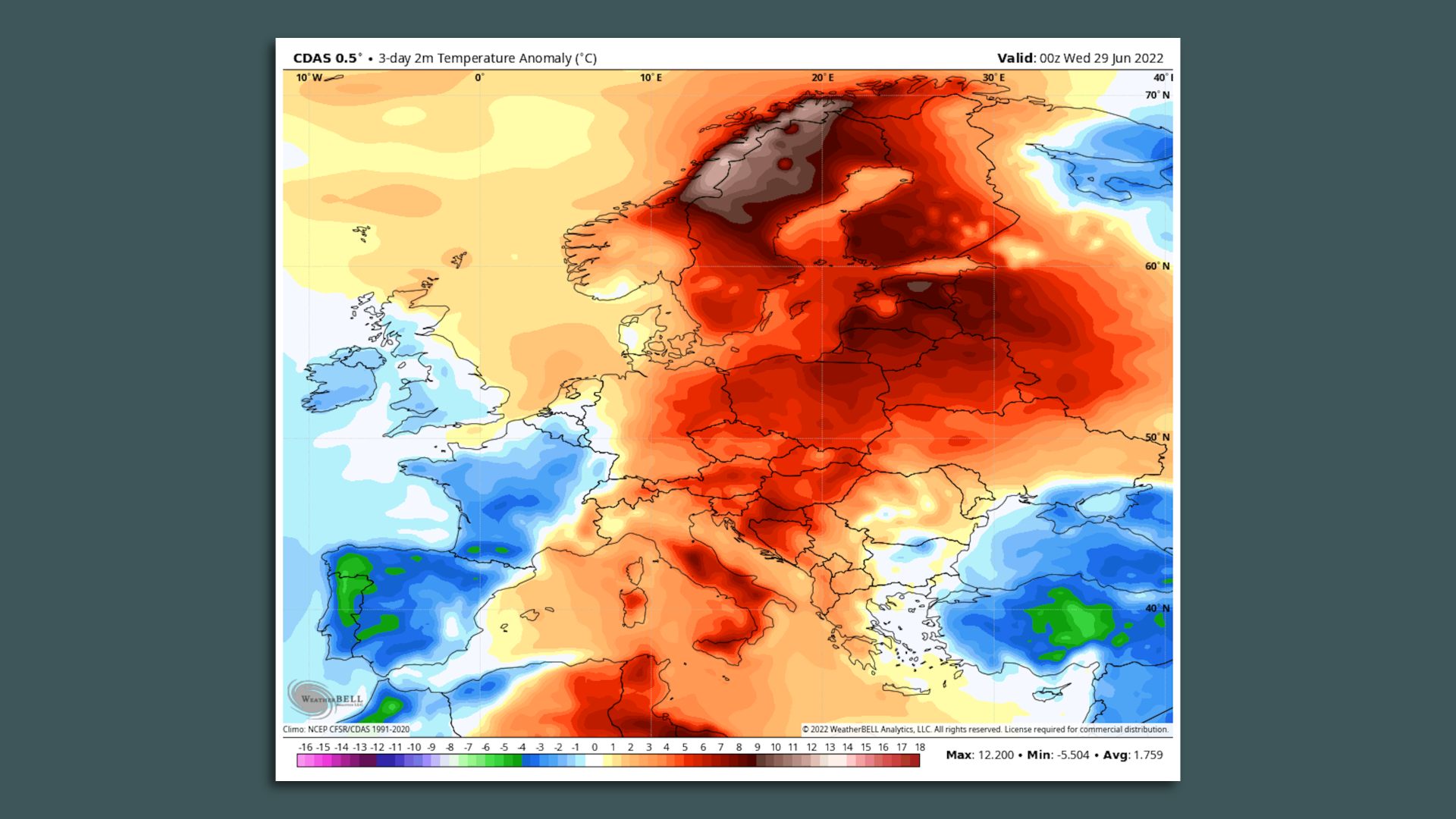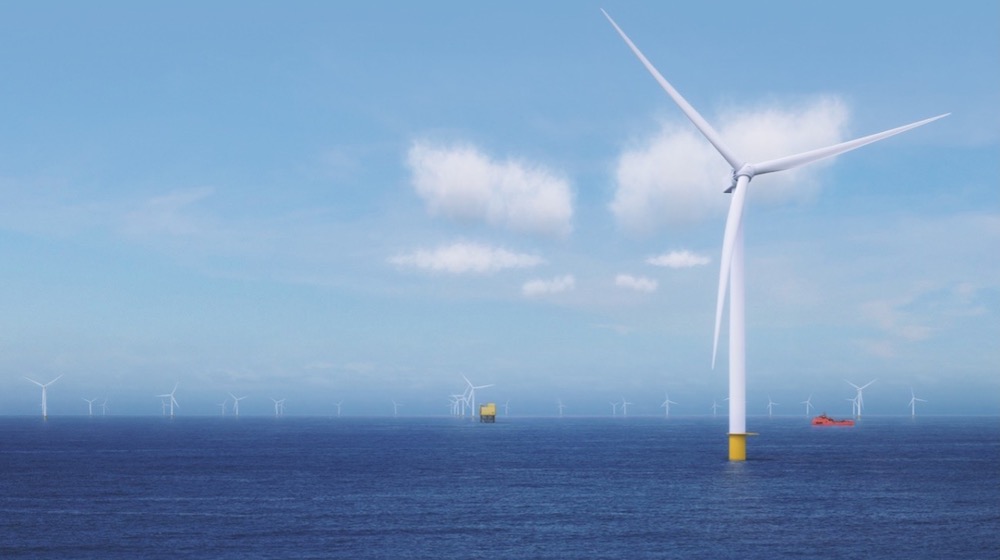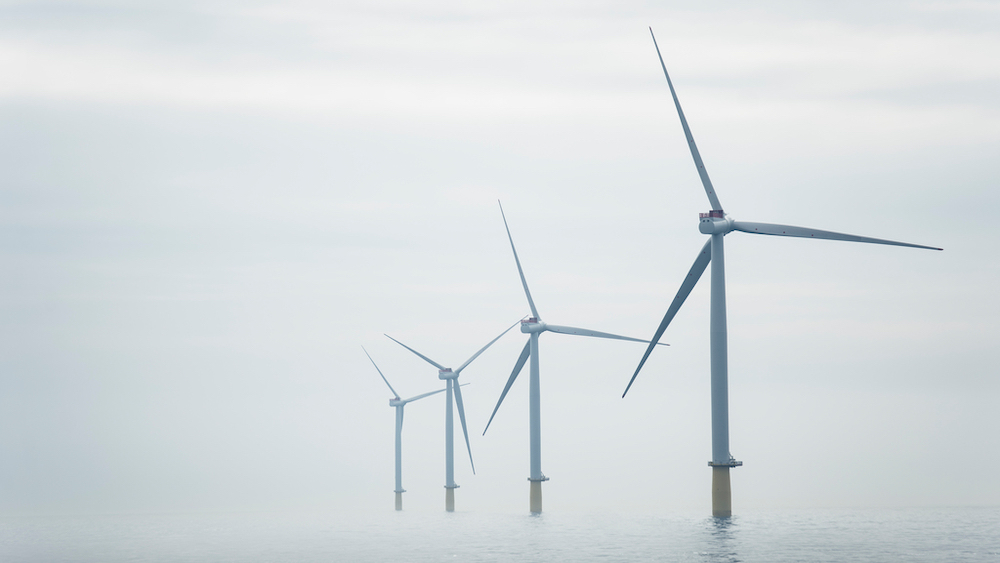| | | | | | | Presented By Equinor | | | | Axios Generate | | By Ben Geman and Andrew Freedman · Jun 30, 2022 | | 🌄 Good Thursday morning. Today's newsletter, edited by Mickey Meece, has a Smart Brevity count of 1,125 words, 4.5 minutes. 👀 All eyes will be on the U.S. Supreme Court, where a decision in West Virginia v. EPA is expected shortly after 10am ET. Stay tuned to Axios for coverage. 🎶 We head into a big travel weekend with this upbeat 1977 Peter Gabriel song "Solsbury Hill," for today's intro tune. | | | | | | 1 big thing: Heat waves topple records in Europe and Asia |  | | | Map showing temperature anomalies in °C during the past 3 days in Europe ending June 29. (Weatherbell.com) | | | | Monthly and all-time records have been shattered in at least a half-dozen countries, from Europe to Asia during the past week. None of these events have been typical for June, either, Andrew writes. Driving the news: Japan, Italy, Norway, Iran and Finland are a few of the latest nations to see heat records fall like dominoes in an extraordinary month. Why it matters: Studies show that as the climate warms, the frequency of heat waves dramatically increases, as do the severity and longevity of such events. causing heat waves to be more intense, more frequent and longer-lasting. - Extreme heat is deadly, ranking as the top weather-related killer in the U.S. in a typical year.
- It is also stressing power grids, especially in drought-afflicted countries and amid a global energy crunch in the wake of Russia's unprovoked invasion of Ukraine.
State of play: Rome tied its all-time hottest temperature record and set a June milestone on Tuesday, with a reading of 105.4°F. Florence and Naples also set monthly records this week, according to weather historian Maximiliano Herrera. The big picture: The Northern Hemisphere is seeing record heat in multiple places simultaneously during an atypical month for it since most all-time heat records date to July or August. - With a heat dome in place over parts of Europe and low pressure to the west, a plume of hot air from Africa has been pulled north-northeast, all the way to the Arctic.
- Tromsø, Norway, which is above the Arctic Circle, hit 86°F on June 28. This was a monthly record and came within a half-degree of an all-time record for that location.
- Mehamn, Norway, located even further north, reached 87.4°F on Wednesday, obliterating the previous June record of 77.7°F.
Zoom in: Japan is in the grips of one of its worst heat waves on record. The heat is noteworthy for its intensity and persistence. - According to NHK meteorologist Sayaka Mori, 15% of the country had its hottest June day on record Wednesday. Japan saw its first-ever readings of 104°F (40°C) in June, Mori tweeted.
- At least 263 June record highs have been set in six days. Tokyo set a record for the most consecutive days at or above 95°F, Mori said via Twitter, with five such days. The country could set its hottest temperature on record today or tomorrow.
Of note: The Washington Post reports at least 100 people have been hospitalized in Japan due to the hot weather, and millions are being told to conserve power due to the heat-related surge in demand. - "Tokyo metropolitan government staff workers have been advised to work in the dark," the Post reports. "At supermarkets across the country, lights were switched off in freezers. Electrical appliances at homeware stores have been unplugged."
The bottom line: Heat waves are a typical summer hazard, but like with so many extreme weather events, climate change is transforming them into something more dangerous and disruptive. - And July starts tomorrow.
Read more. |     | | | | | | 2. NOAA adds funding for coastal restoration and wildfire research |  | | | Illustration: Sarah Grillo/Axios | | | | NOAA rolled out hundreds of millions in new funding opportunities under the Bipartisan Infrastructure Law to make coastal ecosystems more resilient, Andrew writes. Why it matters: The funding, highlighted in a press call yesterday, comprises a rare infusion of money into fortifying the nation's coasts in the face of increasingly powerful hurricanes and sea level rise. - The law provides about $1.5 billion over five years for programs under the "Climate Ready Coasts" category, which includes natural infrastructure projects that build coastal resilience, store carbon, remove marine debris and restore habitat.
What they're saying: "This is really the first time I've seen true new money being put into an environmental program like this," Rick Spinrad, administrator of the National Oceanic and Atmospheric Administration, said in an interview. - "For us, what it's going to allow us to do is what we're really good at, in terms of coastal resilience, but to do it at a scale we've never been able to do before."
- Spinrad said the agency will put some of the money to use trying to clean up marine plastics, a topic of growing public concern.
Between the lines: The coastal funding is only part of the funding NOAA plans to put to use from the law over five years. - Other money will go to the agency's weather and climate functions.
- The law provides $80 million for research supercomputing, $50 million for wildfire research, and $492 million for flood inundation mapping and forecasting.
|     | | | | | | 3. The global electricity bounce back |  The economic resurgence in the wake of the COVID pandemic lockdowns helped drive an increase in electricity generation worldwide last year, according to the latest BP Statistical Review of World Energy, Andrew writes. Why it matters: The trends in the report show several positive and negative climate change-related storylines. - For example, wind and solar energy, which are now the cheapest forms of energy in many parts of the world, reached a 10.2% share of power generation, the first time they have exceeded 10%.
- Renewable primary energy, which includes biofuels but not hydroelectric plants, saw an annual growth rate of 15% in 2021, higher than any other fuel category.
Zoom in: Global electricity generation increased by 6.2% in 2021, which was nearly identical to the 6,4% bounce back in 2010 after the financial crisis. - While natural gas-generated power ticked up by 2.6%, fossil fuel's share decreased to 22.9% from 23.7%.
- Part of this trend was due to a rebound in coal power generation, whose share climbed to 36% last year from 35.1% in 2020. Coal is the most carbon-intensive power source.
Between the lines: Coal consumption grew more than 6% last year, to reach its highest level since 2014, the report found. China and India accounted for more than 70% of this growth, but consumption increased in Europe and North America last year as well. |     | | | | | | A message from Equinor | | How Equinor is becoming a leader in America's offshore wind industry | | |  | | | | Equinor will power about 2 million homes in New York with renewable energy — boosting the economy, generating jobs and building new wind energy infrastructure. We're committed to becoming net-zero by 2050 by advancing the development of the Empire Wind and Beacon Wind offshore wind projects. | | | | | | 4. 🏃🏽 Catch up fast: nuclear plants, China's new plans | | ☢️ Nuclear power is "poised for a resurgence" in many countries, a new International Energy Agency report states. Why it matters: Nuclear can play a key part in decarbonizing the power sector, the IEA finds. However, many countries, including the U.S., are reliant on decades-old technology, with most new nuclear power plant construction taking place in Asia. - "Extending nuclear plants' lifetimes is an indispensable part of a cost-effective path to net zero by 2050," the report states.
What's next: Technological advances in small modular reactors could help nuclear grow in countries where its market share is currently flatlined or shrinking. 🏭 China plans to cut its industrial energy intensity by 13.5% during the 2021-2025 period by implementing new technologies, standards and other innovations, according to a Reuters report based on a new action plan out yesterday. Zoom in: China National Offshore Oil Corp. also unveiled a new plan yesterday that involves spending more on clean energy technologies. - The plan calls for CNOOC to peak its carbon emissions by 2028, and reach net zero by 2050. Bloomberg has more.
|     | | | | | | A message from Equinor | | The energy transition is the defining opportunity of our time | | |  | | | | Equinor is accelerating the energy transition by growing our renewable energy portfolio and cutting greenhouse gas emissions. Through the Empire Wind and Beacon Wind offshore wind developments, we will power about 2 million homes in New York with renewable energy. | | | | 📬 Did a friend send you this newsletter? Welcome, please sign up. Thanks for reading and see you back here tomorrow. |  | It's called Smart Brevity®. Over 300 orgs use it — in a tool called Axios HQ — to drive productivity with clearer workplace communications. | | | | | | Axios thanks our partners for supporting our newsletters. If you're interested in advertising, learn more here.
Sponsorship has no influence on editorial content. Axios, 3100 Clarendon Blvd, Suite 1300, Arlington VA 22201 | | | You received this email because you signed up for newsletters from Axios.
Change your preferences or unsubscribe here. | | | Was this email forwarded to you?
Sign up now to get Axios in your inbox. | | | | Follow Axios on social media:    | | | | | |







No comments:
Post a Comment